Next: 3.3 SEList: A Space-Efficient Up: 3. Linked Lists Previous: 3.1 SLList: A Singly-Linked Contents Index
A DLList (doubly-linked list) is very similar to an SLList except
that each node
![]() in a DLList has references to both the node
in a DLList has references to both the node
![]() that follows it and the node
that follows it and the node
![]() that precedes it.
that precedes it.
When implementing an SLList, we saw that there were always several
special cases to worry about. For example, removing the last element
from an SLList or adding an element to an empty SLList requires care
to ensure that
![]() and
and
![]() are correctly updated. In a DLList,
the number of these special cases increases considerably. Perhaps the
cleanest way to take care of all these special cases in a DLList is to
introduce a
are correctly updated. In a DLList,
the number of these special cases increases considerably. Perhaps the
cleanest way to take care of all these special cases in a DLList is to
introduce a
![]() node.
This is a node that does not contain any data,
but acts as a placeholder so that there are no special nodes; every node
has both a
node.
This is a node that does not contain any data,
but acts as a placeholder so that there are no special nodes; every node
has both a
![]() and a
and a
![]() , with
, with
![]() acting as the node that
follows the last node in the list and that precedes the first node in
the list. In this way, the nodes of the list are (doubly-)linked into
a cycle, as illustrated in Figure 3.2.
acting as the node that
follows the last node in the list and that precedes the first node in
the list. In this way, the nodes of the list are (doubly-)linked into
a cycle, as illustrated in Figure 3.2.
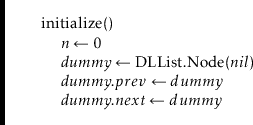
Finding the node with a particular index in a DLList is easy; we can
either start at the head of the list (
![]() ) and work forward,
or start at the tail of the list (
) and work forward,
or start at the tail of the list (
![]() ) and work backward.
This allows us to reach the
) and work backward.
This allows us to reach the
![]() th node in
th node in
![]() time:
time:
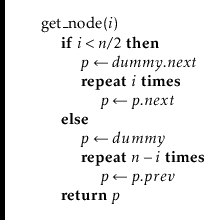
The
![]() and
and
![]() operations are now also easy. We first find the
operations are now also easy. We first find the
![]() th node and then get or set its
th node and then get or set its
![]() value:
value:
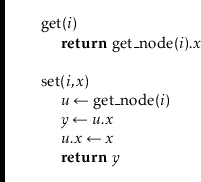
The running time of these operations is dominated by the time it takes
to find the
![]() th node, and is therefore
th node, and is therefore
![]() .
.
If we have a reference to a node
![]() in a DLList and we want to insert a
node
in a DLList and we want to insert a
node
![]() before
before
![]() , then this is just a matter of setting
, then this is just a matter of setting
![]() ,
,
![]() , and then adjusting
, and then adjusting
![]() and
and
![]() . (See Figure 3.3.)
Thanks to the dummy node, there is no need to worry about
. (See Figure 3.3.)
Thanks to the dummy node, there is no need to worry about
![]() or
or
![]() not existing.
not existing.
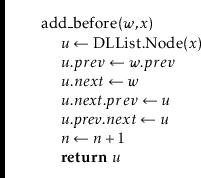
Now, the list operation
![]() is trivial to implement. We find the
is trivial to implement. We find the
![]() th node in the DLList and insert a new node
th node in the DLList and insert a new node
![]() that contains
that contains
![]() just before it.
just before it.

The only non-constant part of the running time of
![]() is the time
it takes to find the
is the time
it takes to find the
![]() th node (using
th node (using
![]() ). Thus,
). Thus,
![]() runs in
runs in
![]() time.
time.
Removing a node
![]() from a DLList is easy. We only need to adjust
pointers at
from a DLList is easy. We only need to adjust
pointers at
![]() and
and
![]() so that they skip over
so that they skip over
![]() . Again, the
use of the dummy node eliminates the need to consider any special cases:
. Again, the
use of the dummy node eliminates the need to consider any special cases:
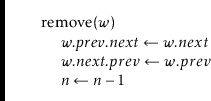
Now the
![]() operation is trivial. We find the node with index
operation is trivial. We find the node with index
![]() and remove it:
and remove it:

Again, the only expensive part of this operation is finding the
![]() th node
using
th node
using
![]() , so
, so
![]() runs in
runs in
![]() time.
time.
The following theorem summarizes the performance of a DLList:
It is worth noting that, if we ignore the cost of the
![]() operation, then all operations on a DLList take constant time.
Thus, the only expensive part of operations on a DLList is finding
the relevant node. Once we have the relevant node, adding, removing,
or accessing the data at that node takes only constant time.
operation, then all operations on a DLList take constant time.
Thus, the only expensive part of operations on a DLList is finding
the relevant node. Once we have the relevant node, adding, removing,
or accessing the data at that node takes only constant time.
This is in sharp contrast to the array-based List implementations of Chapter 2; in those implementations, the relevant array item can be found in constant time. However, addition or removal requires shifting elements in the array and, in general, takes non-constant time.
For this reason, linked list structures are well-suited to applications where references to list nodes can be obtained through external means.
opendatastructures.org